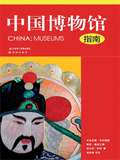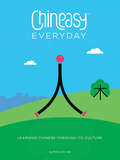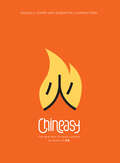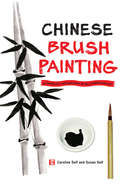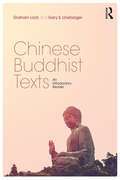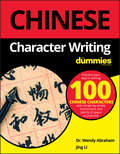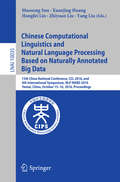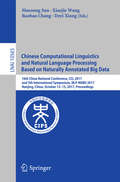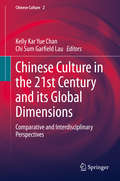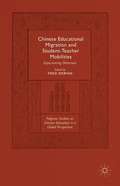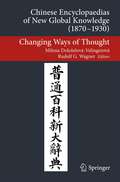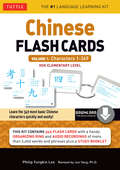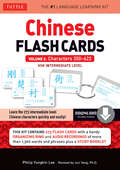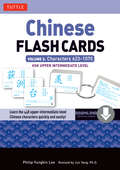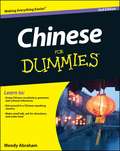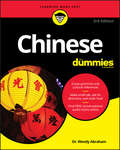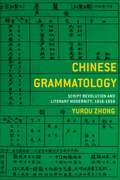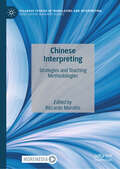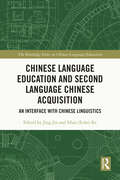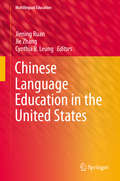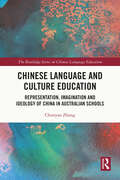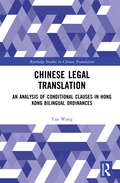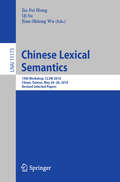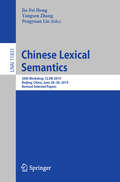- Table View
- List View
China: Museums (Mandarin Edition)
by Miriam CliffordChina: Museums unlocks the doors to over 200 must-see museums, ranging from art and archeology, science and technology to history and politics. Pertinent information supplements entries and highlights of key objects are illustrated with over 500 color images. 本书作者是三位外国记者与专栏作家 他们在中国游历多年 特别是参观了中国两百多家博物馆 以外国人的角度介绍了各博物馆的藏品及展览特色等 本书介绍的博物馆 按地区,省,市划分 使用方便 特别收录了易被忽视的博物馆,介绍了博物馆必看展品以及适合儿童参观的博物馆 提供了迄今最准确的地址,联系方式,网址 中英文对照的博物馆名称 并配有近千幅精美图片 书中记录的每一家博物馆都会给你带来启发 依此而游 博物馆的藏品与展览之旅会令你的旅行大为增色 当然也会成为进一步理解中国艺术,文化,社会与历史的起点
Chineasy Everyday: Learning Chinese Through Its Culture
by ShaoLanThe New Way to Read ChineseShaoLan Hsueh, a Taiwanese entrepreneur based in London, couldn’t find an effective way to teach her children Chinese, so she developed a groundbreaking visual method to make reading characters fun and easy. By learning the most commonly occurring characters—the building blocks of the entire language—readers of all ages can swiftly grasp basic concepts and words.Chineasy Everyday teaches more than four hundred of the most useful Chinese characters, phrases, and sentences. Organized into eleven themes that reflect daily life, this book brings the stories and myths behind the characters to life, providing a unique perspective into Chinese history and culture.“These cute images make reading Chinese characters ‘Chineasy.’”—NPR’s “Code Switch” blog“In her delightful book...Hsueh offers an inspired approach to learning more than four hundred Chinese characters.”—San Francisco Chronicle blog
Chineasy: The Easy Way to Learn Chinese
by ShaoLan HsuehChinese is considered one of the most difficult languages to master. However, using the Chineasy system, anyone can begin to understand and read Chinese. It works by transforming Chinese characters into illustrations to make them easy to remember. This book teaches the key characters on which the language is built and how these characters can be combined to form more complex words and phrases. Learning Chinese has never been this simple or more fun!
Chinese
by Jerry NormanThis general introduction to the study of the Chinese language traces its history from its beginings in the second millennium BC to the present day and provides a clear picture of the contemporary language and its sociolinguistic status. Chinese in its numerous dialect forms, has more speakers than any language in the modern world, and this vast extension in time and space brings to its study an exceptional complexity. Nevertheless, Professor Norman handles this extraordinary range of material with a deftness of organization and lucid elegance of style that make his book of real interest to any reader with only an elementary knowledge of linguistics. It includes information on the genetic and typological connections of Chinese, traditional Chinese phonology, the writing system, the classical and early vernacular languages, the modern language and the non-standard dialects, and the history of linguistic reform in China, concluding with a discussion of present and future prospects. This latest volume in the Cambridge Language Surveys will not only be welcomed by scholars and students of the Chinese language, but also by readers with a wider interest in Chinese studies and Asian language specialists in general. Like previous volumes in the series, it makes a significant contribution to general descriptive linguistics and language typology.
Chinese Brush Painting
by Caroline Self Susan SelfChinese ink painting is an offshoot of calligraphy and is a beautiful and reflective art that's been revered in China for centuries. A wonderfully creative tool, this book is an excellent way for newcomers to experience this ancient art form.Traditional black-and-white Chinese ink painting elements, along with the tradition's essentials--such as the quality and variety of the tools and accessories used in its practice are all covered. The Art of Chinese Brush Painting encourages readers to be mindful of the principles of composition and perspective, and introduces specific techniques for several different elements, including Chinese Zodiac animals and landscapes.
Chinese Buddhist Texts: An Introductory Reader
by Graham Lock Gary S. LinebargerThe influence of Buddhism on the Chinese language, on Chinese literature and on Chinese culture in general cannot be overstated, and the language of most Chinese Buddhist texts differs considerably from both Classical and Modern Chinese. This reader aims to help students develop familiarity with features of Buddhist texts in Chinese, including patterns of organization, grammatical features and specialized vocabulary. It also aims to familiarize students with the use of a range of resources necessary for becoming independent readers of such texts. Chinese Buddhist Texts is suitable for students who have completed the equivalent of at least one year’s college level study of Modern Chinese and are familiar with roughly one thousand of the commonest Chinese characters. Previous study of Classical Chinese would be an advantage, but is not assumed. It is an ideal textbook for students taking relevant courses in Chinese studies programs and in Buddhist studies programs. However, it is also possible for a student to work through the reader on his or her own. Further online resources are available at: lockgraham.com
Chinese Character Writing For Dummies
by Jing Li Wendy AbrahamLearn to write 100 characters in Chinese Billions of people worldwide speak Chinese—and now you can learn to write 100 characters in the world’s most-spoken language! Whether you’re taking a course, looking to get ahead at work, or just want to up the ante when you’re communicating with Chinese-speaking family and friends, Chinese Character Writing For Dummies gets you up to speed fast. This workbook will guide your first steps in learning Chinese characters. It contains 100 basic characters, including 44 simple characters (pictograms and symbols) and 56 composite characters (ideograms and ideo-phonograms). It helps you little by little to familiarize yourself with the pieces of the puzzle most frequently used, as well as some basic Chinese writing rules. Offers online bonus content that includes instructional videos, downloadable flashcards, and printable writing pages Shows you how to write 100 Chinese characters Provides instruction for beginners, students, and lifelong learners Gives you helpful tips on how to memorize characters Speaking Chinese will take you far—and learning to write some of the most common characters will only take you farther! Find out how Chinese Character Writing For Dummies can help you today!
Chinese Computational Linguistics and Natural Language Processing Based on Naturally Annotated Big Data: 15th China National Conference, CCL 2016, and 4th International Symposium, NLP-NABD 2016, Yantai, China, October 15-16, 2016, Proceedings (Lecture Notes in Computer Science #10035)
by Yang Liu Maosong Sun Zhiyuan Liu Xuanjing Huang Hongfei LinThis book constitutes the proceedings of the 15th China National Conference on Computational Linguistics, CCL 2016, and the 4th International Symposium on Natural Language Processing Based on Naturally Annotated Big Data, NLP-NABD 2016, held in Yantai City, China, in October 2016. The 29 full papers and 8 short papers presented in this volume were carefully reviewed and selected from 85 submissions. They were organized in topical sections named: semantics; machine translation; multilinguality in NLP; knowledge graph and information extraction; linguistic resource annotation and evaluation; information retrieval and question answering; text classification and summarization; social computing and sentiment analysis; and NLP applications.
Chinese Computational Linguistics and Natural Language Processing Based on Naturally Annotated Big Data: 16th China National Conference, CCL 2017, and 5th International Symposium, NLP-NABD 2017, Nanjing, China, October 13-15, 2017, Proceedings (Lecture Notes in Computer Science #10565)
by Deyi Xiong Maosong Sun Xiaojie Wang Baobao ChangThis book constitutes the proceedings of the 15th China National Conference on Computational Linguistics, CCL 2016, and the 4th International Symposium on Natural Language Processing Based on Naturally Annotated Big Data, NLP-NABD 2016, held in Yantai City, China, in October 2016. The 29 full papers and 8 short papers presented in this volume were carefully reviewed and selected from 85 submissions. They were organized in topical sections named: semantics; machine translation; multilinguality in NLP; knowledge graph and information extraction; linguistic resource annotation and evaluation; information retrieval and question answering; text classification and summarization; social computing and sentiment analysis; and NLP applications.
Chinese Culture in the 21st Century and its Global Dimensions: Comparative and Interdisciplinary Perspectives (Chinese Culture #2)
by Kelly Kar Yue Chan Chi Sum Garfield LauThis book investigates the internationalization of Chinese culture in recent decades and the global dimensions of Chinese culture from comparative and interdisciplinary perspectives. It covers a variety of topics concerning the contemporary significance of Chinese culture in its philosophical, literary and artistic manifestations, including literature, film, performing arts, creative media, linguistics, translations and philosophical ideas. The book explores the reception of Chinese culture in different geographic locations and how the global reception of Chinese culture contrasts with the local Chinese community. The chapters collectively cover gender studies and patriarchal domination in Chinese literature in comparison to the world literature, explorations on translation of Chinese culture in the West, Chinese studies as an academic discipline in the West, and Chinese and Hong Kong films and performances in the global context. The book is an excellent resource for both scholars and students interested in the development of Chinese culture on the global stage in the 21st Century.
Chinese Educational Migration and Student-Teacher Mobilities
by Fred DervinChina has awakened but is international education ready? Chinese students, teachers and staff are now familiar faces in universities around the world and this original volume examines their multifaceted experiences in Australia, Denmark, France, Japan, the UK and the US. The authors propose case studies that will appeal to an international audience interested in one of the most mobile populations in global Higher Education. By doing so they question some of the assumptions and misleading facts about Chinese students, teachers and staff abroad. This volume will serve both as a solid introduction and as a thorough review for more knowledgeable readers.
Chinese Encyclopaedias of New Global Knowledge: Changing Ways of Thought (Transcultural Research – Heidelberg Studies on Asia and Europe in a Global Context)
by Rudolf G Wagner Milena Doleželová-VelingerováThis is a set of pioneering studies on Chinese encyclopaedias of modern knowledge (1870-1930). At a transitional time when modern knowledge was sought after yet few modern schools were available, these works were crucial sources of information for an entire generation. This volume investigates many of these encyclopaedias, which were never reprinted and are hardly known even to specialists, for the first time. The contributors to this collection all specialize in the period in question and have worked together for a number of years. The resulting studies show that these encyclopaedias open a unique window onto the migration and ordering systems of knowledge across cultural and linguistic borders.
Chinese Flash Cards Kit Volume 1
by Philip Yungkin Lee Jun YangEverything you need to learn the 349 most basic Chinese characters quickly and easily - our #1 language learning kit now for your ebook! 349 Flash Cards. A Handy Organizing Ring. Audio Recordings of More than 2000 words and phrases. Plus a 32-page study booklet.To succeed in mastering Chinese characters, there are just 3 secrets: begin with the most useful characters, study them in the most effective order, and use repetition galore!Flash cards remain one of the most effective tools for rapid memorization, and Tuttle's flash cards are the best available today. Whether on a train from Beijing to Shanghai or sitting under a tree in Berkeley, you can be practicing your Chinese with this well-designed, easy-to-use set of flashcards.Developed with HSK study and AP test-prep in mind, the front of Tuttle's Flash Cards give one Chinese character, a stroke order guide, 4 words and phrases, and look-alike alerts to help avoid confusion. On the reverse is as much information as a dictionary entry: Romanized pronunciation and English meanings, sample sentences for correct usage, plus helpful mnemonics and learning tips. An audio CD gives native-speaker pronunciations and a handy organizing ring is the perfect way to
Chinese Flash Cards Kit Volume 2
by Philip Yungkin Lee Jun YangFlash cards remain an easy, effective tool for rapid memorization, and Tuttle's flash cards are the best available today.The front of each card gives one Chinese character. On the reverse is as much information as a dictionary entry: stroke order, radicals, vocabulary, idiomatic phrases, and sample sentences. An audio CD gives native-speaker pronunciations. An excellent tool for HSK study, this second volume will help you master the 273 intermediate-level characters, along with their associated 1,360+ words and sentences.Whether at home or on the go, you can use these cards to learn several new characters every day, and watch your knowledge develop rapidly over time. This kit features: 273 hole-punched cards presenting the essential intermediate-level characters. Native-speaker audio recordings of 1,360+ example words and sentences. A 32-page study booklet with sorting indexes and practice tips. Radicals, compounds and idiomatic phrases, plus traditional forms where applicable. A handy organizing ring is included to hold the cards.
Chinese Flash Cards Volume 3
by Philip Yungkin Lee Jun YangFlash cards are one of the quintessential keys to successful language learning, and Chinese Flash Cards ebook Volume 3 contains all the necessary ingredients you need to read and write Chinese.Many Chinese language students understand that there are three secrets to committing these Chinese characters, or Hanzi, to memory: start with the basic characters first, then study the others in the correct order, and use constant repetition to reinforce them until they stick in your long-term memory. No other study tool is better equipped to handle this task other than flash cards, making this ebook an ideal resource for practicing Chinese. These handy flash cards present the characters in the correct order and the cards have a full range of features to help you master the 448 Upper Intermediate level characters, along with their associated 2,240+ words and sentences. All characters needed for the HSK Upper Intermediate Level exam are covered. The HSK is China's standard test of Chinese proficiency for non-native speakers, required of foreigners who wish to study or work at Chinese universities and firms.Whether at home or on the go, you can use these cards to learn several new characters every day, and watch your knowledge develop rapidly over time.This ebook features: 448 hole-punched cards presenting the essential intermediate-level characters. Native-speaker downloadable audio recordings of 2,240+ example words and sentences. A 32-page study booklet with sorting indexes and practice tips. Radicals, compounds and idiomatic phrases, plus traditional forms where applicable. Ideal as a study tool to prepare for China's official HSK exam.
Chinese For Dummies
by Wendy AbrahamThe fast and easy way to learn to speak Mandarin ChineseChina has become a major influence in the world today, and Mandarin Chinese is the world's most widely spoken language. Not only is China full of opportunities in business and politics, but Chinese culture, continues to make its way into the western world. With an updated CD including real-life conversations, Chinese For Dummies expands grammar, verb conjugations, and pronunciations--and includes a refreshed mini-dictionary complete with even more essential vocabulary. Basic vocabularyEveryday conversations, including phone dialogue and small talkSpeaking in perfect pitch and toneEasy-to-understand grammar rulesGetting around in a Chinese-speaking countryCultural references like maintaining face, dining etiquette, and social moresAlso included is an audio CD that features actual Chinese conversations by native Chinese speakers, which allows you to hear how Chinese is really spoken. Written by a leading Chinese language teacher in the United States, Chinese for Dummies introduces an often-daunting language to you in a fun-and-easy For Dummies manner.CD-ROM/DVD and other supplementary materials are not included as part of the e-book file, but are available for download after purchase.
Chinese For Dummies
by Wendy AbrahamThe fun way to learn to speak Chinese With more than 1.2 billion speakers across the globe — and with nearly 3 million in the U.S. alone — Mandarin Chinese claims the top spot as the world’s most common language. If you want to learn this language to get ahead at school or work, or to make your travel to China easier, this is the handy reference you’ll want by your side. Chinese For Dummies teaches basic grammar, as well as the necessary vocabulary to make introductions and greetings, use proper etiquette, make small talk, make transportation arrangements, order food and beverages, ask directions, deal with money, shop, access recreation, and handle an emergency. Concentrates on Mandarin Chinese and features new and revised content Includes major updates to all the necessary foundational information needed to speak Chinese Covers grammar, verb conjugations, and pronunciations Offers a refreshed mini-dictionary complete with even more vocabulary Find free conversational audio tracks online As the Chinese economy continues to grow, the importance of Chinese as a trade language will also increase. If you’re a student or business professional who has a basic understanding of the language, you’ll be poised to surpass your peers when it comes to dealing with international markets. So get started today!
Chinese Grammatology: Script Revolution and Literary Modernity, 1916–1958
by Yurou ZhongToday, Chinese characters are described as a national treasure, the core of the nation’s civilizational identity. Yet for nearly half of the twentieth century, reformers waged war on the Chinese script. They declared it an archaic hindrance to modernization, portraying the ancient system of writing as a roadblock to literacy and therefore science and democracy. Movements spanning the political spectrum proposed abandonment of characters and alphabetization of Chinese writing, although in the end the Communist Party opted for character simplification.Chinese Grammatology traces the origins, transmutations, and containment of this script revolution to provide a groundbreaking account of its formative effects on Chinese literature and culture, and lasting implications for the encounter between the alphabetic and nonalphabet worlds. Yurou Zhong explores the growth of competing Romanization and Latinization movements aligned with the clashing Nationalists and Communists. She finds surprising affinities between alphabetic reform and modern Chinese literary movements and examines the politics of literacy programs and mass education against the backdrop of war and revolution. Zhong places the Chinese script revolution in the global context of a phonocentric dominance that privileges phonetic writing, contending that the eventual retention of characters constituted an anti-ethnocentric, anti-imperial critique that coincided with postwar decolonization movements and predated the emergence of Deconstructionism. By revealing the consequences of one of the biggest linguistic experiments in history, Chinese Grammatology provides an ambitious rethinking of the origins of Chinese literary modernity and the politics of the science of writing.
Chinese Interpreting: Strategies and Teaching Methodologies (Palgrave Studies in Translating and Interpreting)
by Riccardo MorattoThis book dives into the world of Chinese interpreting, exploring fundamental challenges and topics such as consecutive and simultaneous interpreting, medical, courtroom and media interpreting, as well as interculturality. The book establishes a strong theoretical foundation, delving into principles and techniques for successful Chinese interpreting, before proceeding to examine note-taking in consecutive interpreting, strategies for effective information organization, and providing valuable insights through practical examples. The authors explore the realm of Chinese simultaneous interpreting, examining techniques for conveying meaning in real-time and addressing the unique challenges of medical interpreting. The book also covers the impact of technology on interpreting, the integration of artificial intelligence, and ethical considerations. With its theoretical foundations, practical examples, and in-depth exploration of various topics, this book serves as an indispensable resource for aspiring interpreters, practitioners seeking to enhance their knowledge, and researchers aiming to investigate the intricate world of Chinese interpreting.
Chinese Language Education and Second Language Chinese Acquisition: An Interface with Chinese Linguistics (The Routledge Series on Chinese Language Education)
by Jing Jin Sihui KeThis edited volume presents the latest scholarly endeavors to synergize Chinese linguistics with Chinese language education and L2 Chinese acquisition, a direction of inquiry that has emerged as a rapidly developing area and attracted both teaching practitioners and linguists’ interests in recent years.The studies presented in the volume approach a diversity of issues, ranging over linguistics-informed Chinese language education in the contexts of Hong Kong, mainland China, and overseas countries; language pedagogies along various linguistic approaches; L2 Chinese development of different linguistic properties; bilingualism and multilingualism among adult and school learners; as well as linguistically grounded Chinese language learning and teaching via digital means. The volume offers to deepen the reader’s understanding of the existing theories on Chinese language education and L2 Chinese acquisition, and the linguistic theories regarding the nature, component modules, and development of the human language faculty. It also offers new pedagogical inspiration, based on cutting-edge empirical research, for Chinese language teaching in different educational settings.Of interest to scholars in the fields of Chinese language teaching and learning, second language acquisition, or applied linguistics, this volume contributes to the emerging field of educational applications of linguistics and presents an overarching framework that bridges a long-lasting division between language teaching practice and linguistic research.
Chinese Language Education in the United States (Multilingual Education #14)
by Jie Zhang Jiening Ruan Cynthia B. LeungThis book offers historical, philosophical, and sociocultural perspectives on Chinese language education for speakers of other languages with a special focus on Chinese language education in the United States. It provides a comprehensive, cross-disciplinary look at changes in CFL/CSL education over time in China and the U. S. and the philosophical, political and sociocultural influences that led to these changes. The essays address a wide array of topics related to Chinese language education, including: A historical overview of the field Theories that apply to CFL/CSL learning Policies and initiatives for CFL/CSL by the Chinese and U. S. governments Medium of instruction Curriculum and instruction for CFL/CSL learners at K-12 and college levels Technology for CFL/CSL education Chinese language learning for heritage learners CFL in study abroad contexts CFL teacher education and training This work is essential reading for scholars and students interested in gaining a greater understanding of Chinese language education in the two countries and around the world.
Chinese Language and Culture Education: Representation, Imagination and Ideology of China in Australian Schools (The Routledge Series on Chinese Language Education)
by Chunyan ZhangAgainst the background of the Australian government’s strategic plan to promote Asian languages in schools, this book is an innovative autoethnographic inquiry into what actually occurs in the implementation of a Chinese language and culture program in an Australian context.Drawing on eight years of socio-cultural and educational fieldwork in a primary school, Chunyan Zhang examines complex, fluid and heterogeneous daily teaching practices and the ways in which ideas of China are assembled, presented and performed. She asks the following questions: What is China? Where does Taiwan fit into the China depicted in a multicultural, globalised classroom? Can Chinese communism or Chairman Mao be avoided in teaching English-speaking learners? What kind of China is brought in here while what kind of China is being silenced and othered? Through the partial connection between method assemblage and Daoist concepts, Zhang develops a water-like pedagogy in teaching. She uses the knowledge flow model to examine the imbalanced knowledge flow within teacher-student interactions. From finding China as a hybrid assemblage to proposing China as method, Zhang’s investigation makes an important contribution to the sociology of Chinese language education.This book is an essential and rich content resource for primary and secondary teacher education and research, teacher candidates and educators in Chinese as a second language education.
Chinese Legal Translation: An Analysis of Conditional Clauses in Hong Kong Bilingual Ordinances (Routledge Studies in Chinese Translation)
by Wang YanChinese Legal Translation analyses and investigates the Chinese translation of conditional clauses introduced by various introductory words in Hong Kong bilingual ordinances within the framework of descriptive translation studies and translation typology. This book explores the text typology of Hong Kong bilingual ordinances and highlights differences and similarities between different translations of conditional clauses in the Hong Kong context. Based on both quantitative and qualitative analysis of conditional clauses of the Companies Ordinance, the book summarises the frequency of introductory words of conditional clauses and generalises guiding patterns for writing conditional clauses and translating conditional clauses. The book is significant in providing both theoretical foundations for legal translation and practical guidance for translating legal conditional clauses. This book is primarily targeted for scholars and professionals who are interested in legal writing and legal translation, as well as for students and practitioners in legal translation.
Chinese Lexical Semantics: 19th Workshop, CLSW 2018, Chiayi, Taiwan, May 26–28, 2018, Revised Selected Papers (Lecture Notes in Computer Science #11173)
by Jia-Fei Hong Qi Su Jiun-Shiung WuThis book constitutes the thoroughly refereed post-workshop proceedings of the 19th Chinese Lexical Semantics Workshop, CLSW 2018, held in Chiayi, Taiwan, in May 2018. The 50 full papers and 19 short papers included in this volume were carefully reviewed and selected from 150 submissions. They are organized in the following topical sections: Lexical Semantics; Applications of Natural Language Processing; Lexical Resources; Corpus Linguistics.
Chinese Lexical Semantics: 20th Workshop, CLSW 2019, Beijing, China, June 28–30, 2019, Revised Selected Papers (Lecture Notes in Computer Science #11831)
by Jia-Fei Hong Yangsen Zhang Pengyuan LiuThis book constitutes the thoroughly refereed post-workshop proceedings of the 20th Chinese Lexical Semantics Workshop, CLSW 2019, held in Chiayi, Taiwan, in June 2019. The 39 full papers and 46 short papers included in this volume were carefully reviewed and selected from 254 submissions. They are organized in the following topical sections: lexical semantics; applications of natural language processing; lexical resources; corpus linguistics.
